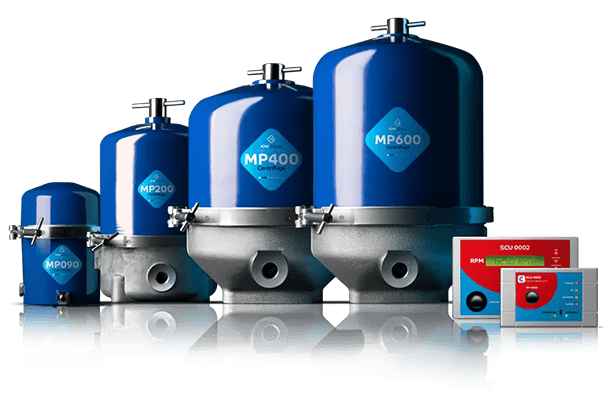What is a centrifugal oil separator
and how does it work?
What is a centrifugal oil separator?
A centrifugal oil separator utilizes centrifugal force to separate solids from a liquid phase. Drawing out solid particles from the processed fluid to achieve a smoother operation of the engine/application by reducing wear on engine components. During the clarification process (liquids/solids separation), the cleaned oil moves towards the bowl center and discharges through the outlet. The solid contaminants move towards the bowl periphery and collect on the centrifugal bowl wall.
Centrifugal separators are used across various industries and are suitable to protect a wide range of applications from harmful contaminants. They are commonly used within the natural gas, power generation, transport, marine, and mining industries to separate products from liquid for varied uses.
Centrifugal oil separators are usually cylindrical-shaped units that will turn and rotate at high speed within a larger stationary container. Most large centrifugal separators have disc stacks to assist with filtration. This creates a larger surface area for faster separation and helps deliver heavier particulate to the outer bowl wall.
Some centrifugal separators are pressure-powered, others are directly powered by motors.
What is a centrifugal separator?
A centrifugal oil separator is a device used to separate solids from a liquid phase. Removing solid particles and heavy liquid from the processed fluid to achieve a smoother operation of the engine/application. During the clarification process (liquids/solids separation), the cleaned oil moves towards the bowl center and discharges through the outlet. The solid contaminants move towards the bowl periphery and collect on the centrifugal bowl wall.
Centrifugal separators are used across various industries and are suitable to protect a wide range of applications from harmful contaminants. They are commonly used within the natural gas, power generation, transport, marine, and mining industries to separate products from liquid for varied uses.
Centrifugal oil separators are usually cylindrical-shaped units that will turn and rotate at high speed within a larger stationary container. Most large centrifugal separators have disc stacks to assist with filtration. This creates a larger surface area for faster separation and helps deliver heavier particulate to the outer bowl wall.
Some centrifugal separators are process liquid-driven (pressure-driven). Others are directly powered by motors, or alternatively, can also be indirect drive where the drive is generated through belts and gears.
What does a centrifugal oil separator do?
The main aim of a centrifugal oil separator is to remove impurities and particulate from the lubrication oil to encourage the engine's high performance and economical operation. Poor lube oil quality may cause increased wear on the crankshaft, camshaft, turbocharger, and other vital parts, and replacement of expensive components may be required.
Why use a centrifugal oil separator?
Centrifugal oil separators are considered the most efficient oil filtration option. While the initial investment is higher than disposable filters, the return on investment is quick. Due to the reduction in particulate, the maintenance required is reduced, and unexpected downtime or failures can be avoided. Centrifugal oil separators can be mounted on trollies to be mobile and help clean the oil for several machines. They can be attached to tanks to clean in one location continuously, or they can be mounted on the engine in a bypass kidney-loop system where small amounts of oil are withdrawn from circulation to be cleaned before returning to the sump ready for use.
What does a centrifugal separator do?
The main aim of a centrifugal oil separator is to remove impurities and particulate from the lubrication oil to encourage high performance and economical operation of the engine.
Why use a centrifugal separator?
Centrifugal separators are considered the most efficient oil filtration option. whilst the initial investment is higher, compared to disposable filters, the return on investment is quick. Due to the reduction in particulate, the maintenance required is reduced, and unexpected down time or failures can be avoided. Separators can be mounted on trollies to be mobile and help clean the oil for several machines. They can be attached to tanks to continuously clean in one location, or they can be mounted on the engine in a bypass kidney-loop system where small amounts of oil are withdrawn from circulation to be cleaned before returning to the sump ready for use.
How does a centrifugal separator work?
A centrifugal filter harnesses centrifugal force to force the separation of liquids. As the separator spins at high speed, centrifugal force is generated much greater than gravity. The dense particles (solid particles and heavy liquid) are forced to the outer bowl wall due to the centrifugal force created in the unit. Through this enhanced gravitational force, even the smallest particles are slung out of the oil to form a stiff sludge cake on the outer bowl wall, ready for easy removal.
What are the benefits of using a centrifuge oil separator?
There are many benefits to opting for a centrifugal oil separator. Effective oil filtration minimizes the wear on the engine and its components. As a result, engine lifespan increases, and maintenance required is reduced. Due to the reduced engine wear, unexpected downtime and failures are avoided, increasing your machinery's productivity. These factors lower the total cost of ownership (TCO), making your investment more profitable.
A beneficial environmental factor is the extended use of lubrication oil. Oil lifespan can be substantially increased by using a centrifugal oil separator and conducting regular oil analysis. This reduces oil consumption and reduces your carbon footprint. Fewer resources are used, and maintenance teams are free to focus on tasks other than oil changes. All of these factors can create considerable savings within organizations.
How does a centrifugal separator work?
A centrifugal filter harnesses centrifugal force to force the separation of liquids. As the separator spins at high speed, centrifugal force is generated much greater than gravity. The dense particles (solid particles and heavy liquid) are forced to the outer bowl wall due to the centrifugal force created in the unit. Through this enhanced gravitational force, even the smallest particles are slung out of the oil to form a stiff sludge cake on the outer bowl wall, ready for easy removal.
What are the benefits of using a centrifuge oil separator?
There are many benefits to opting for a centrifugal oil separator. By effectively filtering oil, you minimize the wear on the engine and its components. As a result, engine lifespan is increased and maintenance required is reduced. Both these factors lower the total cost of ownership (TCO) making your investment more profitable. Due to the reduced engine wear unexpected downtime and failures are avoided increasing the productivity of your machinery.
A beneficial environmental factor is the extended use of lubrication oil. Through the use of a centrifugal oil separator and regular oil analysis, oil lifespan can be substantially increased. This reduces oil consumption and reduces your carbon footprint. Fewer resources are used, and engineering teams are free to focus on other tasks than performing oil changes that may not be required! All of these factors can create considerable savings within organizations.
How does a centrifugal separator work?
A centrifugal filter harnesses centrifugal force to force the separation of liquids. As the separator spins at high speed, centrifugal force is generated much greater than gravity. The dense particles (solid particles and heavy liquid) are forced to the outer bowl wall due to the centrifugal force created in the unit. Through this enhanced gravitational force, even the smallest particles are slung out of the oil to form a stiff sludge cake on the outer bowl wall, ready for easy removal.
What are the benefits of using a centrifuge oil separator?
There are many benefits to opting for a centrifugal oil separator. By effectively filtering oil, you minimize the wear on the engine and its components. As a result, engine lifespan is increased and maintenance required is reduced. Both these factors lower the total cost of ownership (TCO) making your investment more profitable. Due to the reduced engine wear unexpected downtime and failures are avoided increasing the productivity of your machinery.
A beneficial environmental factor is the extended use of lubrication oil. Through the use of a centrifugal oil separator and regular oil analysis, oil lifespan can be substantially increased. This reduces oil consumption and reduces your carbon footprint. Fewer resources are used, and engineering teams are free to focus on other tasks than performing oil changes that may not be required! All of these factors can create considerable savings within organizations.
Centrifugal oil separators are considered the most efficient and reliable form of filtration. Centrifugal separator units are not disposable filters and are considered to be long-lasting, reliable, and durable products for effective filtration. They have a fast return on investment due to the benefits outlined above.
The benefits
- Reduction in engine wear
- Reduction in use of lubricating oil
- Saves man-hours in cleaning
- Reduced waste disposal costs
- Simple to operate and maintain
- Same-day dispatch available on request for spares in stock
- Extends service intervals
- Extends life of primary filters
- Capital cost investment returned quickly
- Environmentally friendly
- Bolt-on/bolt-off for existing installations
The IOW Group manufactures and supplies the next generation of centrifugal oil separators
The IOW centrifuge is a modernized design from the traditional centrifugal oil separator, containing patent-protected features only available with an IOW Group centrifuge. Thanks to the improved design, there is no chance of cross-contamination between the dirty and cleaned oil. Ensuring all contaminants removed are contained within the bowl and ready for disposal.
The IOW centrifuge range is the smallest of its kind to utilize bowl disc technology. The central bowl disc stack provides a greater surface area for fast and finer separation. The bowl disc stack also assists in delivering the larger particulate to the outer bowl wall and forces even the smallest particles out of the oil.
One of the IOW centrifuge's most innovative and revolutionary features is the choice of remote monitoring units (SCUs). The external monitors allow operators to access data regarding the centrifuge; this is not available with any other product. It gives the ability to measure the centrifuge performance, set alarms based on various factors, and give insight into when service is required. The CentriClean SCU0003 model provides this data via the CentriClean App meaning information is immediate and easily available. Whereas the CentriClean SCU0002 has data available immediately on the front screen. By providing this data, man-hours spent on the centrifuge are reduced due to having access to this precious data.
Combining all these features makes the IOW centrifuge range 150% more efficient than any other available product. Lloyds tested and proven to beat the competition. The IOW centrifuge can give you the competitive edge within your industry.
To find out more, get in touch with one of our experts today.
Contact the IOW Group
We will get back to you as soon as possible
Please try again later



